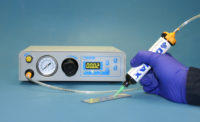Phenolic resins have been industrially important since the late 19th century.
Phenolic resins are some of the oldest synthetic compounds known. Phenolics were originally derived from wood byproducts and coal distillates, and have been industrially important since the late 19th century. Wood alcohol, also derived from wood, could be steam-oxidized to formaldehyde, and phenol-formaldehyde resins became the basis for the laminating glue in plywood, the miracle composite of its time.
Phenol-formaldehyde resins were used to produce some of the first synthetic adhesives. Treatment with amines produced melamines. Treatment with epichlorohydrin produced the first epoxidized phenols, or epoxy resins. These products come from two major forms of oligo-phenols. Bisphenols are reaction products between phenol and a ketone, and typically have 2 to 4 epoxy groups per molecular unit. Novolacs begin as a pre-oligomerized system having 5 to 10 phenols tied together and are further epoxidized to produce viscous liquid or solid epoxies.
Many low molecular weight phenolic resins are soluble in water or are pre-polymerized in a water solution. They can be polymerized with either base (resole) or acid (novolac) catalysts. Resoles are usually liquids and novolacs are often solids. Resoles provided inexpensive, waterborne technology and paved the way to reinforcing paper and fabric by saturating them. Later versions were 100 percent solids used to bond plastics and metals.
When the change was made to laminated paper composites and then to fiberglass composites, phenolic resins were the natural choice for those advanced materials. Offshoots such as Formica and Melmac were often used to replace wood products in counter tops and to produce sterilizable eating ware. Phenolic plastics became part of the standard for modern, sanitary eating conditions.
Phenol-based molecular structures have an average carbon content of 75 percent to 80 percent. The advantages are high temperature, humidity and chemical resistance, and high fire retardancy. The disadvantage is the natural brittleness of highly cross-linked systems and the difficulty of toughening the resins.
Using reinforcement fibers to make composite phenolic plastics increased toughness and electrical resistance, and phenolics were quickly adopted as insulators. The infinite formability into molded, machinable shapes also gave them an advantage over ceramic and glass. Phenolic resins were among the first high-performance electrical insulators and paved the way for part of the electronics revolution. The first circuit boards were phenolic-paper. While high-end electronics began using epoxy-glass boards in the 1960s, phenolic board stock was still in use for consumer electronics well into the 1990s.
Phenolics are enjoying a resurgent interest because of their fire retardance and low smoke generation. This is particularly important for decorative and structural panels in confined spaces. Using carbon fiber specifically for fire retardancy produces composites with extraordinary fire and smoke performance at temperatures greater than 1,000 F. Their natural fire retardance also makes them attractive as adhesives for high-temperature applications such as binders for foundry sand molds.
When used as adhesives, phenolics have the disadvantage of poor toughness. The highly rigid, cross-linked structure of phenolics makes them difficult to toughen using methods employed with more linear epoxy derivatives. Rubber modification of phenolics is not very effective. It is also difficult to introduce other components that are more flexible into phenolics.
For example, there aren’t phenolics based on aliphatic polyethers, as there are epoxies. Toughened phenolics will display modest increases in fracture strength but, as a class, the options for toughening phenolics are few. When employed for high-temperature resistance, toughness is not usually a primary concern-the strength at temperature is more important.
Phenol resins are inexpensive and waterborne, and are still used in the wood products industry. However, stringent control of formaldehyde emission levels has reduced their use. Phenolic resins with low levels of formaldehyde are used as additives to boost the performance of other waterborne adhesives.
Phenol-based resins can be cross-linked with acrylic and urethane chemistries. Although advanced hot-melt formulations have supplanted phenolic resins in some applications, RF-cured molded wood laminations made with waterborne phenolic resins produce curved plywood shapes for furniture and architectural details. Curved plywood offering rigidity and a finished look that rivals solid hardwood is still found in high-style furniture.
Phenolic resins have played an important role in the history of polymers, adhesives, composites and advanced materials. New requirements in heat management along with electrical resistance will give even this oldie-but-goodie a chance to relive its past as a breakthrough technology. Old technology doesn’t have to act old.



